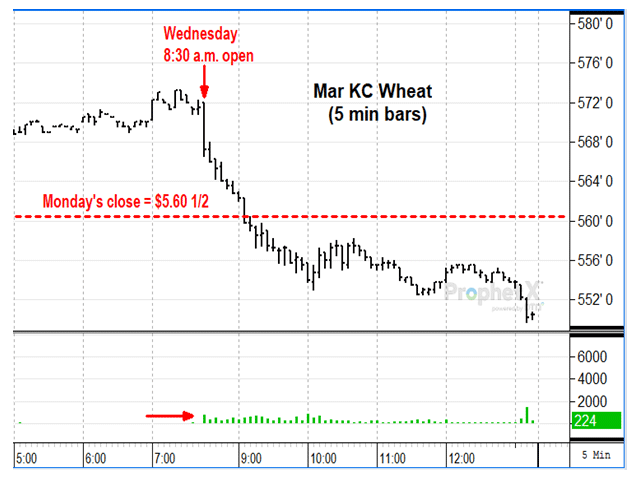Todd's Take
Wheat's Funny Behavior
Here at DTN, we market analysts are always looking for the latest market information to explain the moves of the day. I can't say it's always easy to do, but on most days -- if we do our homework -- there's usually a reasonable explanation behind significant market moves. Some days, of course, the market doesn't move much at all and that's understandable -- market-moving news doesn't happen every day.
On Tuesday and Wednesday of this week (Nov. 24 and 25), the wheat markets reminded us sometimes traders like to play games with prices and it's no coincidence that strange things can happen during holiday weeks when trade volume is low and trader attention is diverted.
On Tuesday, March KC wheat closed up 10 1/4 cents with 30,780 contracts traded -- more than 10,000 contracts above what was traded Monday. Looking at 5-minute charts, there was no obvious one-time buying surge after the 8:30 a.m. CST bell. Just a few hundred contracts or so every five minutes was enough to convince sellers to run away and make room for wheat's higher prices.
CFTC's latest Commitments of Traders report showed noncommercials (speculators) net long 52,274 contracts as of Nov. 17, so they weren't opposed to Tuesday's rally. Knowing noncommercials tend to follow trends, they probably added to their long positions. This was also a day when corn and soybean prices were slightly lower. Perhaps some corn/wheat spreads were being unraveled?
Fundamentally, it was difficult to explain why wheat prices were so popular with bulls Tuesday, while corn and soybeans traded lower. Here in late November, wheat crops around the Northern Hemisphere are nearing dormancy and this is typically a quiet time of year. There just wasn't a strong explanation for the rally other than prices appeared to have found support after five weeks of trading in a narrow range.
The bigger surprise happened on Wednesday after the 8:30 a.m. CST bell. In the first five minutes of trading, March KC wheat fell 4 1/4 cents on 792 contracts and proceeded to make new lows throughout the morning. The selling volume was fairly consistent until shortly after 10 a.m. when it turned quiet as buyers gave up and the selling eased. By the end of Wednesday's session March KC wheat dropped 20 1/4 cents to $5.50 1/2 on 30,948 contracts traded.
P[L1] D[0x0] M[300x250] OOP[F] ADUNIT[] T[]
Once again, there was no significant fundamental change in the market to explain the big drop. Drought remains a concern for the U.S. hard red winter (HRW) wheat crop and there is no significant rain chance in either the 7-day forecast or for the forecast of the following week.
There was mention Jordan may have canceled a tender. On Thursday, Dow Jones reported Egypt bought 175,000 metric tons (mt) of wheat from Russia. But neither of those explain a 20-cent drop in KC wheat prices.
I often say markets are people and people are emotional. I should have also mentioned that sometimes people are prone to pilfering, as the behavior of Tuesday's and Wednesday's prices looks mischievous, to put it lightly.
Manipulating prices is nothing new to markets and it usually goes like this: Someone with the ability to trade a lot of contracts finds a time when market attention is low, like before Thanksgiving, and pushes the market one direction. Tuesday's rising prices likely encouraged more of the herd to go long.
With the trading herd leaning long, the manipulator reversed course Wednesday and sold, sold, sold. In basketball, getting an opponent to lean left and then pivoting right is called an ankle breaker, and the best athletes are very good at it. On Wednesday, noncommercials found themselves surprised once again and likely had to bail out of long positions, not expecting a 20-cent drop on the day before Thanksgiving.
I admit, I don't have proof Wednesday's selling was intentionally orchestrated and I don't know who the master manipulator might be, if there was one. I do know traders would describe similar scenarios in the days of trading pits and I have long witnessed odd trading behavior near holidays.
For noncommercial traders, the CME has position limits of 12,000 contracts for all contracts of KC wheat futures. Just recently, the CFTC adopted new position limits, which will expand the position limit on spot contracts of corn, soybeans and wheat futures from 600 to 1,200 contracts.
Given this week's low-volume trading environment ahead of Thanksgiving, it is fair to say the current position limits do nothing to prevent the kind of suspicious trading behavior witnessed this week. I can't prove KC wheat prices were manipulated and, honestly, there may not be a good way to prevent this kind of funny business in the future. Regrettably, for America's farmers and ranchers, it's long been part of the cost of doing business.
**
DTN market analysts make general market comments for educational purposes, but do not make specific recommendations for particular farm situations. The buying and selling of commodities and futures contracts involve substantial risk and are not suitable for everyone.
Todd Hultman can be reached at Todd.Hultman@dtn.com
Follow him on Twitter @ToddHultman1
(c) Copyright 2020 DTN, LLC. All rights reserved.




